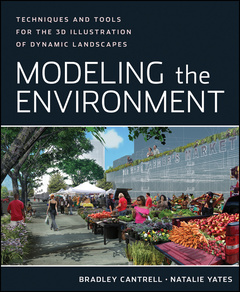Description
Modeling the Environment
Techniques and Tools for the 3D Illustration of Dynamic Landscapes
Authors: Cantrell Bradley, Yates Natalie
Language: English
Subject for Modeling the Environment:
71.26 €
In Print (Delivery period: 14 days).
Add to cart288 p. · 19.1x23.1 cm · Paperback
Description
/li>Contents
/li>Biography
/li>
A single-source guide to harnessing the power of 3D visualization tools for analysis and representation of landscapes
Current technology allows designers to model environmental phenomena and space in new and exciting ways that go beyond the two-dimensional plane. The models, illustrations, and animations that can be created usher in a new paradigm of landscape representation that can become analytical tools as well as beautiful imagery. The text focuses on digital modeling methods that can be used to express rich environments using digital tools to develop, composite, and animate scenes.
This full-color book provides coverage of 3D visualization tools for land planning and landscape architecture. The methods and theories in Modeling the Environment present landscape representation around a core set of ideasscene, object, terrain, environment/atmosphere, time/dynamics, and the compositethat centers representation on human experience. Supported by www.lab.visual-logic.com, a website offering tutorials and forums, the text shows you how to use Autodesk 3ds Max to create dynamic landscape environments while also referring to a range of other tools including Google SketchUp, Autodesk Maya, and AutoCAD Civil 3D. It also demonstrates how to integrate 3D visualization tools into existing workflows, and offers critical coverage of intelligent drawings and representations, giving you a glimpse at the future of the profession. This book:
Includes sections intended to build upon one another in order to understand the environment as a composite representation of multiple systems interacting
Shows how to integrate 3D visualization tools into existing workflows, as opposed to offering an entirely new workflow
Emphasizes modeling, animation, and simulation as both design analysis tools and presentation tools
Modeling the Environment is essential reading for professionals in landscape architecture, urban planning and design, architecture, and related disciplines who are looking to be at the forefront of technology.
Foreword
Preface
Acknowledgments
Part 1: Introduction
Chapter 1: Overview of Media
Chapter 2: Digital Media Industries
Chapter 3: Digital Media
Chapter 4: Representation, Illustration and Simulation
Chapter 5: Design Practice
Part 2: Scene
Chapter 6: Diorama: Setting the Stage
Chapter 7: Arranging the Elements
Chapter 8: Composition & Views
Chapter 9: Movement in the Environment
Part 3: Object
Chapter 10: Object
Chapter 11: Overview Modeling
Chapter 12: Using CAD Linework
Chapter 13: Polygon Modeling
Chapter 14: Spline Modeling
Chapter 15: Materiality
Part 4: Terrain
Chapter 16: Terrain . Surface
Chapter 17: Terrain Construction
Chapter 18: Terrain Modeling . Meshes
Chapter 19: Surface Materials
Chapter 20: Distributions
Part 5: Atmosphere
Chapter 21: Lighting . Atmosphere
Chapter 22: Rendering and Lighting Systems
Chapter 23: Atmospheric Conditions
Chapter 24: Advanced and Realtime Lighting Systems
Chapter 25: Temporal Atmospheres
Part 6: Simulation
Chapter 26: Animation
Chapter 27: Linking . Controllers
Chapter 28: Animation Techniques
Chapter 29: Simulation . Rigid Bodies
Chapter 30: Simulation . Particles and Soft Bodies
Chapter 31: Scripting
Part 7: Composite
Chapter 32: Composite Imagery
Chapter 33: Composite . Scene States . Batch
Chapter 34: Illustrative Composite
Chapter 35: Animated Composite
Bibliography
Image Credits
Index
Bradley Cantrell is Principal and Partner at Visual Logic, Inc.; Partner at LND Digital Workshop, Digital Media Training and Consulting; and Associate Professor in the Robert Reich School of Landscape Architecture at Louisiana State University. He is the coauthor of Digital Drawing for Landscape Architecture (Wiley). Natalie Yates is Assistant Professor of Landscape Architecture in the Sam Fox School of Design and Visual Arts at Washington University in St. Louis.

